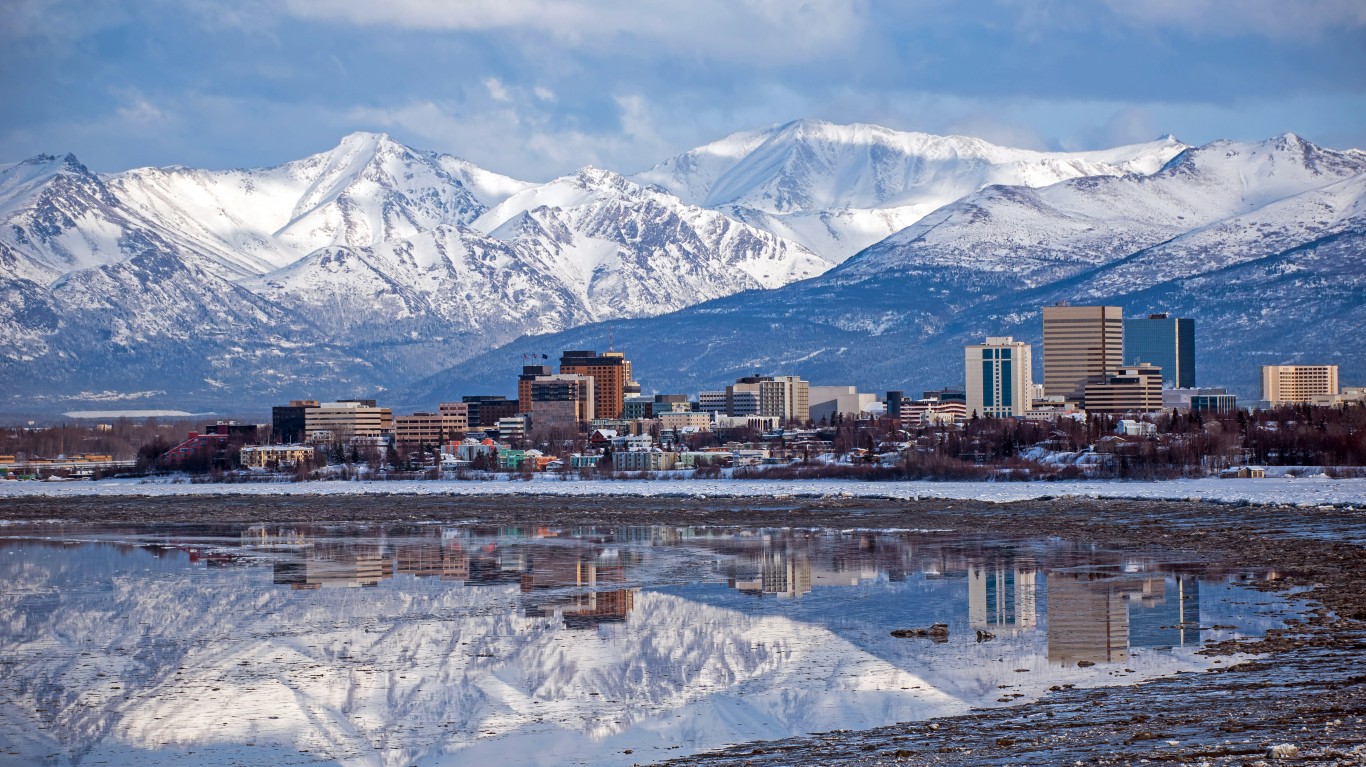Special Report
States With No Income Tax

Published:
Last Updated:

Individual income taxes are the largest source of income for the federal government, accounting for 48% of federal tax revenue. Income taxes are similarly important to the vast majority of state government balance sheets. Most Americans pay income taxes to both the federal government, and to their state.
There are, however, a handful of states that manage to function without relying on individual income taxes. To identify the states with no income tax, 24/7 Wall St. reviewed the tax code in each state using the latest tax data compiled by tax policy research organization Tax Foundation. All data included in the article came from the Tax Foundation’s Facts & Figures 2020: How Does Your State Compare? report.
In the vast majority of states, individual income taxes represent over 15% of annual tax revenue. Because income tax is such an important and reliable revenue source, the states with no income tax make up for the lost potential revenue in other ways.
Two states on this list, for example, have major tourist industries and raise revenue through higher than average sales taxes. Three other states are rich in natural resources and are able to bring in additional revenue through taxes on mineral and gas extraction operations. These are the states with the lowest and highest gas taxes.
Click here to see the states with no income taxes

1. Alaska
> 2018 personal income per capita: $59,420 (10th highest)
> 2018 total state tax collections per capita: $2,226 (8th lowest)
> 2018 state debt per capita: $7,986 (4th highest)
> Largest source of state+local tax revenue: Property tax (51.8% of total)
Alaska is one of seven states that does not levy an individual income tax. A resource-rich state, Alaska is in a unique position to shift tax burdens from individual residents to oil and gas extraction companies. Alaska has some of the largest oil fields in the United States. Because of the revenue it derives from these fields, not only does the state not levy an individual income tax, but also it does not levy a sales tax — although some local governments in the state are allowed to levy their own sales taxes. Resource extraction revenue covers much of the government’s budget and allows the state to pay residents a dividend every year. Alaskans were paid $1,606 each in 2019 from the state’s permanent fund.
With no individual income or sales tax, a disproportionately large share of total tax revenue in Alaska comes from property tax. State and local governments derived 51.8% of total tax revenue from property tax in fiscal 2018, far more than the 31.9% national average.
[in-text-ad]

2. Florida
> 2018 personal income per capita: $50,070 (23rd lowest)
> 2018 total state tax collections per capita: $2,158 (6th lowest)
> 2018 state debt per capita: $1,296 (5th lowest)
> Largest source of state+local tax revenue: Property tax (36.4% of total)
States with no individual income tax make up for the lost revenue source in other ways. Florida is one of the most visited states in the country, and as a result, tourism generates enough revenue to cover much of the difference. Florida levies a 6.0% sales tax, a higher rate than the majority of states — and that rate is applied to residents as well as to the more than 100 million tourists who visit the Sunshine State each year. Florida collected $1,388 per resident in sales taxes in fiscal 2018, far more than the average per capita sales tax revenue collected across all states of $970.
Still, Florida derives most of its tax revenue from property taxes, although sales taxes are not far behind. Property taxes in the state account for 36.4% of overall tax revenue, while sales taxes account for 36.2%.

3. Nevada
> 2018 personal income per capita: $49,176 (22nd lowest)
> 2018 total state tax collections per capita: $3,018 (23rd highest)
> 2018 state debt per capita: $1,132 (3rd lowest)
> Largest source of state+local tax revenue: Sales tax (41.1% of total)
Due in large part to revenue generated by Nevada’s tourism industry, state residents do not pay state income tax. Clark County — home to Las Vegas — drew over 42 million visitors in 2018, leading to over $10.2 billion in gaming revenue alone.
Nevada levies a 6.85% sales tax, a higher sales tax rate than all but six other states. With the higher-than-average sales tax rate paid by visitors and residents alike, Nevada collected the equivalent of $1,679 per person in sales tax alone in fiscal 2018, greater than all but two other states. Including both state and local collections, Nevada also generates more revenue per capita in excise taxes — those levied on certain goods and activities, like gasoline and gambling — than every state other than Vermont.

4. South Dakota
> 2018 personal income per capita: $52,216 (22nd highest)
> 2018 total state tax collections per capita: $2,174 (7th lowest)
> 2018 state debt per capita: $4,239 (15th highest)
> Largest source of state+local tax revenue: Sales tax (38.7% of total)
With no state individual income tax, South Dakota generates far less revenue on a per capita basis than most other states. The state collected just $2,174 per resident in fiscal 2018, about $980 less than the average across all states. Sales tax accounts for the largest share of South Dakota’s state and local tax revenue at 38.7%, followed by property taxes, which account for 38%.
In part because it collects so little in taxes, federal aid accounts for a larger than typical share of South Dakota’s revenue. Federal assistance is typically dispersed to supplement state funding and support projects determined to be of national interest. In South Dakota, federal dollars accounted for approximately 34.8% of revenue in fiscal 2017, compared to the 22.9% across all states.
[in-text-ad-2]

5. Texas
> 2018 personal income per capita: $50,355 (25th lowest)
> 2018 total state tax collections per capita: $2,102 (2nd lowest)
> 2018 state debt per capita: $1,795 (8th lowest)
> Largest source of state+local tax revenue: Property tax (45.0% of total)
Texas is one of several resource-rich states that do not levy a tax on personal income. The Lone Star State is home to some 40% of U.S. proved oil reserves, and it is able to leverage the energy industry to partially offset the lost individual income tax revenue. The state collected $3.4 billion in revenue from oil production and another $1.4 billion from natural gas production in its fiscal 2018.
Relatively high property taxes also help keep the Texas state government funded. Homeowners in Texas pay the equivalent of 1.7% of their property value in taxes per year, more than in all but six other states. State and local governments collected the equivalent of $1,872 in property taxes per resident in fiscal 2017, more than the $1,617 average per capita collection across all states.

6. Washington
> 2018 personal income per capita: $62,026 (7th highest)
> 2018 total state tax collections per capita: $3,527 (12th highest)
> 2018 state debt per capita: $4,502 (14th highest)
> Largest source of state+local tax revenue: Sales tax (46.4% of total)
Washington compensates for the missed income tax revenue with some of the highest sales and excise tax rates in the country. The state levies a 6.5% general sales tax, a higher rate than the vast majority of states. Additionally, the state has one of the highest excise taxes on gasoline and by far the highest excise tax on spirits of any state. Partially as a result, 46.4% of state revenue comes from sales taxes, one of the largest shares of any state.
Though Washington does not have a corporate income tax either, the state does levy a gross receipts tax on businesses, collecting 0.47% of annual gross income of businesses in the state.
[in-text-ad]

7. Wyoming
> 2018 personal income per capita: $60,361 (9th highest)
> 2018 total state tax collections per capita: $3,180 (19th highest)
> 2018 state debt per capita: $1,441 (6th lowest)
> Largest source of state+local tax revenue: Property tax (36.7% of total)
Much like Alaska and Texas, part of the reason Wyoming can afford not to levy an income tax is because of the revenue it generates from its natural resources. The state government levied taxes on over $10 billion in oil, natural gas, coal, and other mineral extraction in 2017. Wyoming also has a relatively low sales tax rate, and partially as a result, property taxes account for 36.7% of state tax revenue, the largest share of any revenue source.
Are you ahead, or behind on retirement? For families with more than $500,000 saved for retirement, finding a financial advisor who puts your interest first can be the difference, and today it’s easier than ever. SmartAsset’s free tool matches you with up to three fiduciary financial advisors who serve your area in minutes. Each advisor has been carefully vetted and must act in your best interests. Start your search now.
If you’ve saved and built a substantial nest egg for you and your family, don’t delay; get started right here and help your retirement dreams become a retirement reality.
Thank you for reading! Have some feedback for us?
Contact the 24/7 Wall St. editorial team.